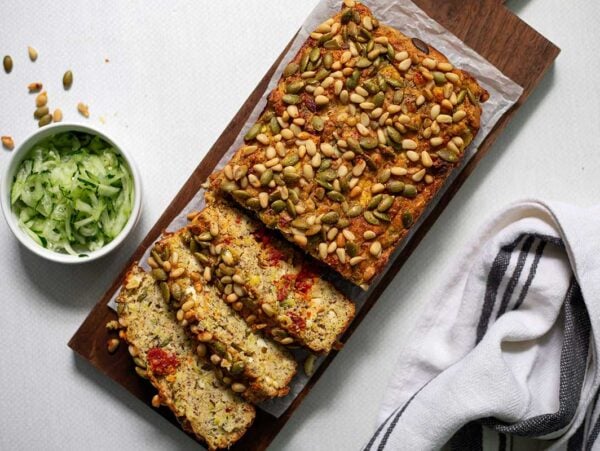Gluten-Free Sourdough Bread
Updated Feb 16, 2021, Published Jun 22, 2018
This post contains affiliate links. Please see our disclosure policy.
If you’re longing for a good gluten-free sourdough bread, this recipe is for you. It’s naturally egg-free and can be made dairy-free, too. (Just use coconut milk for the sourdough starter.)
Yes, it takes a few days to get the sourdough starter going, but it’s not a lot of work. So before you say “it’s too much,” think again. Fresh sourdough bread is well worth the time. In fact, sourdough bread may be the healthiest bread choice, according to University Health News.
Get more gluten-free bread recipes

Gluten-Free Sourdough Bread
Ingredients
- 3 cups all-purpose gluten-free flour blend of choice
- 2 teaspoons xanthan gum
- ¼ teaspoon cream of tartar
- ¼ cup sugar
- 1½ teaspoons kosher salt
- 2 teaspoons active dry yeast
- 1 cup “fed” Sourdough Starter
- 3 tablespoons unsalted butter or dairy-free butter replacement, , melted and cooled
- 1½ cups warm milk or milk of choice, (about 100°F)
Instructions
- Generously grease a 9x5-inch loaf pan. Set aside.
- In the bowl of a stand mixer fitted with the paddle attachment, mix the flour, xanthan gum, cream of tartar, sugar, salt and yeast to combine. Add Sourdough Starter and butter and mix to combine.
- With the mixer on low, pour in the milk in a slow, steady stream. Once the flour has begun to incorporate the liquids, beat the ingredients on at least medium speed for 4 to 6 minutes. The dough will be pretty sticky—thicker than cake batter, not quite as thick as cookie dough. Scrape the dough into the greased loaf pan and smooth the top with wet hands.
- Allow the dough to rise in a warm, humid place for 30 to 45 minutes or until it has about doubled in size. (In a colder, drier environment, this will take longer. If the environment is warm and humid, it may take less time.) While the dough is rising, preheat the oven to 400°F.
- Bake the loaf in preheated oven for 40 to 45 minutes or until a nice, golden brown crust has formed on top.
Nutrition
Nutrition information is automatically calculated, so should only be used as an approximation.
Once you see how easy it can be to make gluten-free bread, you’ll be craving sourdough bread and wishing you had some Sourdough Starter in your refrigerator. Yes, it takes some time and a bit of advanced planning to make sourdough bread but–believe us!–it’s so worth it. And it’s easy.
Need a good quality gluten-free flour for this recipe?
Check out Carol’s Gluten Free All-Purpose Flour:
Sourdough Starter
1 tablespoon active dry yeast
1 cup whole milk or lite coconut milk, room temperature
1 cup white rice flour
1 teaspoon sugar
- In a 1- to 2-quart glass jar (not plastic or metal), dissolve the yeast in the milk by stirring with a wooden spoon. Add the rice flour and sugar and mix to combine well. Cover the jar loosely and allow it to sit at room temperature for 2 to 3 hours. Remember that the milk must be at room temperature for it to activate the yeast.
- The mixture should bubble and appear pockmarked on the surface. It will also likely develop a thin liquid along the top. Stir to incorporate that back into the mixture. Cover the jar again loosely and allow it to sit out on the counter overnight.
- Repeat the procedure in Step 2 for the next two days, stirring to combine, loosely covering, and then stirring again the next day, all the while leaving the jar of starter out on the counter at room temperature.
- If you do not plan to use the starter soon, place it, loosely covered, in the refrigerator. You will need to “feed” it before you use it.
How to “Feed” Your Sourdough Starter
When you know that you want to use your sourdough starter, you will need to plan at least 4 hours ahead.
- Remove the starter from the refrigerator, uncover it, and stir it until smooth with a wooden spoon. Remove one cup of the starter and discard it (or donate it to a friend to create another starter).
- Add ½ cup warm water (about 100°F) and 1 cup white rice flour to the starter. Stir to combine. Allow the starter to sit out at room temperature for at least 4 hours, or overnight, loosely covered. The starter should be bubbling and thick. It is now “fed.”
- Use the amount of starter your recipe calls for. Then replenish the starter by feeding it again with ½ cup warm water and 1 cup white rice flour, stirring to combine, cover again loosely, and return it to the refrigerator.
Originally published in Gluten Free & More. Recipe reprinted with permission from Gluten-Free on a Shoestring by Nicole Hunn. Reprinted by arrangement with Da Capo Lifelong, a member of the Perseus Books Group. Copyright © 2011.















If this is a Nicole Hunn recipe, you MUST go to her website, https://glutenfreeonashoestring.com, and follow the recipe to the letter for it to work correctly. She has very many tips on how to successfully make her recipes.
Yes, we do say in the post that this came from Nicole. We also have a few other sourdough recipes on this site!